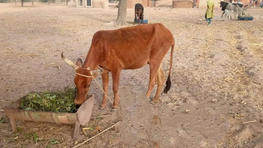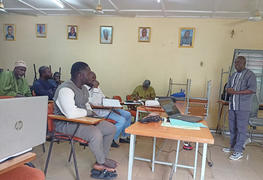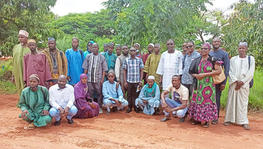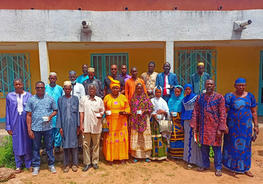Multi-stakeholder Dairy Innovation Platforms (DIPs), vectors of outcomes in the dairy value chains in Burkina Faso
Etienne Sodré, Souleymane Ouédraogo, Barry Mariame (INERA) and Ollo SIB (CIRAD)
On July 14 and 18, 2022, researchers and the members of the Banfora and Bobo-Dioulasso DIPs hold the final workshops of the Africa-Milk project in Burkina Faso in order to present the results of the project, to present the main conclusion of the outcomes harvesting study (assessment of the changes induced by the project), and discuss the prospects for collaboration with the DIPs. Each workshop brought together representatives of the actors of the local dairy value chain coming from the two milkshed (dairy farmers, milk collectors and dairy processors). Dairy farmers who participated in on-farm feeding trials were particularly represented. These workshops were chaired by the heads of decentralized services in charge of livestock (provincial and regional directors of animal and fishery resources).
Baseline studies on dairy-farm carried out in 2019 highlighted a promising dairy-cows feeding management system, on a technical (1.7 l/d/cow compared to 1.08 l/d/cow on average), economical (76,706 FCFA/cow/year of balance on food cost against 36,110 FCFA/cow/year on average) and environmental bases (limited use of industrial feed, and reduction of pressure on pastures). This promising feeding system is based on the distribution of quality fodder, but it is implemented by a very small number of dairy farmers (7% of the farmers surveyed; Sodré et al., 2022). That’s why, from 2019 to 2021, research activities have been focused on the co-design on dairy-cows feeding systems integrating fodder, adapted to the needs of the diversity of dairy farmers. This work was carried out thanks to the strong involvement of the dairy-farmers and the commitment of DIPs leaders. This is how 5 promising forages were tested (by about 211 dairy farmers), and implemented at real scale (by 60 dairy-farmers) who then tested them in real size in their dairy-farm the dry season.
The outcomes substantiation surveys revealed that 97% of the dairy-farmers who experiment the fodders believe that the quantity of milk produced has increased (58% believe that it has increased a little and 39% that it has increased a lot). All dairy farmers who have experimented with fodder (100%) believe that the increase in milk production is due to the improvement of practices for the distribution of supplementary rations integrating more quality cultivated fodder. Around a third of the dairy-farmers (34%) fully attribute this increase to the improvement in fodder availability due to fodder cultivation and the storage of crop residues.
Alongside the farmers who experiment the fodders, direct beneficiaries of the project, some neighbours have, for various reasons, integrated fodder cultivation into their cropping system. Interviews with about twenty of them showed that the main reasons for this are: the desire to increase dry season milk production (75% of dairy farmers), the improvement of income from the sale of milk (17% and 25% of dairy-farmers respectively in Bobo and Banfora) and improving the health of cows (8% of dairy farmers in Bobo Dioulasso). After integrating cultivated fodder into the diet of their dairy-cows, dairy-farmers noted an increase in milk production (100% of the farmers), an increase in income from milk (42% and 75% of the farmers respectively Bobo Dioulasso and Banfora), an improvement in the health of the cows (42% and 13% of farmers respectively in Bobo Dioulasso and Banfora), and other various benefits (33% of farmers in Banfora).
Regarding future collaborations between research and actors in the local dairy value chains, the actors intend to rely on the DIPs of Bobo-Dioulasso and Banfora, which prove to be appropriate bodies for discussing and testing technical and organizational innovations, taking into account the sometime divergent interests and constraints of the actors in the same value chain. The continuation of work on the agroecological intensification of dairy production, based on increased use of the production of quality fodder, but also on more efficient recycling of animal (dairy manure) and plant (crop residues) by-products, has already started as part of the One CGIAR initiative on agroecology.
Sodré É, Moulin C-H, Ouédraogo S, Gnanda IB, Vall É. 2022. Améliorer les pratiques d’alimentation des vaches traites en saison sèche, un levier pour augmenter le revenu des éleveurs laitiers extensifs au Burkina Faso. Cah. Agric. 31: 12.
https://doi.org/10.1051/cagri/2022006
|
|
|
|
|
|
Published: 13/09/2022




